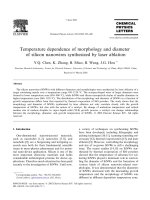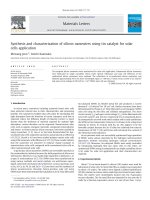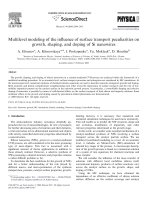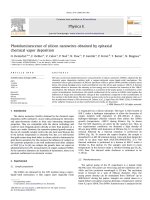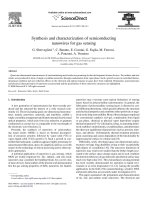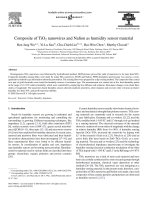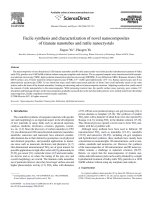- Trang chủ >>
- Khoa Học Tự Nhiên >>
- Vật lý
hydrothermal synthesis and photoluminescence of tio2 nanowires
Bạn đang xem bản rút gọn của tài liệu. Xem và tải ngay bản đầy đủ của tài liệu tại đây (182 KB, 5 trang )
Hydrothermal synthesis and photoluminescence
of TiO
2
nanowires
Y.X. Zhang, G.H. Li
*
, Y.X. Jin, Y. Zhang, J. Zhang, L.D. Zhang
Institute of Solid State Physics, Chinese Academy of Sciences, P.O. Box 1129, Hefei 230031, China
Received 29 July 2002; in final form 20 September 2002
Abstract
Anatase TiO
2
single crystalline nanowires have been successfully synthesized using a simple hydrothermal synthesis
method from TiO
2
nanoparticles. X-ray diffraction, transmission electron microscopy and high-resolution electron
microscopy investigations show the TiO
2
nanowires have high crystallinity with diameter range from 30 to 45 nm and
length in several micrometers. The TiO
2
nanowires can emit blue–green light peaked at 487 nm under excitation at
413 nm.
Ó 2002 Published by Elsevier Science B.V.
1. Introduction
One-dimensional (1D) nanostructured materi-
als have attracted considerable attention due to
their unusual electronic, optical, mechanical
properties and potential applications [1,2]. Over
the past few years, many methods have been suc-
cessfully developed for the fabrication of these
nanowires, including vapor–liquid–solid (VLS) [2],
solution–liquid–solid (SLS) [3], template-based
synthetic approaches [4], arc discharge [5], and
laser ablation [6], which have all been proved to be
very effective methods. However, almost all of the
methods used either catalyst materials or physical
template, which unavoidably brought some con-
tamination to the products. Therefore, it is very
interesting to explore a new approach to synthesize
1D nanomaterials without using preformed tem-
plates or catalyst materials.
Among a large amount of nanomaterials, the
nanostructured titania materials are of great in-
terest for possible application to photovoltaic cells
[7], semiconductor photo-catalyst [8], catalyst
support [9], and gas and humidity sensor [10]. To
date, a few methods have been developed to syn-
thesize TiO
2
nanowires. Li et al. [11] successfully
prepared rutile TiO
2
nanowhiskers by annealing a
precursor powder in which NaCl and TiðOHÞ
4
were homogeneously mixed. Kobayashi et al. [12]
employed supramolecular assemblies to synthesize
TiO
2
hollow-fibres. Recently, Lei et al. [13] and
Zhang et al. [14] have fabricated TiO
2
nanowires in
anodic alumina membranes. In this Letter, we
adopt a simple chemical approach to synthesize
single crystalline anatase TiO
2
nanowires.
Chemical Physics Letters 365 (2002) 300–304
www.elsevier.com/locate/cplett
*
Corresponding author. Fax: +86-551-5591434.
E-mail address: (G.H. Li).
0009-2614/02/$ - see front matter Ó 2002 Published by Elsevier Science B.V.
PII: S 0 0 09-2614(02)01 4 9 9 - 9
2. Experimental
TiO
2
nanowires were prepared using a chemical
process similar to that described by Kasuga and
co-workers [15]. In a typical preparation proce-
dure, 1 g anatase TiO
2
white powders were placed
into a Teflon-lined autoclave of 50 ml capacity.
Then, the autoclave was filled with 10 M NaOH
aqueous solution up to 80% of the total volume,
sealed into a stainless steel tank and maintained at
200 °C for 24 h without shaking or stirring during
the heating. After the autoclave was naturally
cooled to room temperature, the obtained sample
was sequentially washed with dilute HCl aqueous
solution, distilled deionized water and absolute
ethanol for several times. The samples were dried
at 70 °C for 6 h. Finally, soft fibrous powders with
white color were obtained.
The composition of the sample was examined
by a Japan Rigaku Dmax c A X-ray diffractometer
with Cu Ka radiation (k ¼ 1:54056
AA). The mor-
phologies of the sample were analyzed with
scanning electron microscopy (SEM) (JEOL JSM-
6300), transmission electron microscopy (TEM)
(JEM-200CX) and high-resolution electron mi-
croscopy (HRTEM) (JEM-2010). Samples for
SEM observation were presputtered with a layer of
conducting Pt metal. Samples for TEM observa-
tion were prepared by 10 min ultrasonic dispersion
of a small amount of sample in absolute ethanol; a
drop of the solution was then dipped onto a cop-
per microgrid or carbon film and dried in air be-
fore performance. Photoluminescence (PL) spectra
were measured in an Edinburgh FLS 920 spec-
trophotometer with an Xe lamp as the excitation
light source.
3. Results and discussion
The X-ray diffraction (XRD) pattern (Fig. 1)
revealed the overall crystalline structure and phase
purity of the nanowires. All the relatively sharp
peaks could be indexed as anatase TiO
2
with
crystalline cell constants a ¼ 3:7806, c ¼ 9:4977
AA,
which are basically in agreement with the reported
values (JCPDS No. 21-1272). Although the dif-
fraction peak of brookite (denoted as B in Fig. 1)
can also be found, it is much lower than those of
anatase phase. No characteristic peaks of other
impurities, such as NaCl and Na
2
TiO
3
, were ob-
served, which indicates that the product has high
purity.
Fig. 2 showed a typical SEM image of the as-
prepared TiO
2
nanowires. The SEM image indi-
cated the nanowires are very copious in quantity
and quite clean with no contamination attached to
their surface. On the other hand, some of the
nanowires aggregated into bundles in the solution
Fig. 1. XRD pattern of the as-prepared nanowires (A and B
represent anatase and brookite, respectively).
Fig. 2. A typical SEM image of anatase TiO
2
nanowires.
Y.X. Zhang et al. / Chemical Physics Letters 365 (2002) 300–304 301
or during the preparation of SEM sample. This
might explain why some of the nanowires looked
wider than others.
TEM and HRTEM were used to study the fine
structure of the nanowires. Fig. 3a showed a typ-
ical TEM image of an isolated TiO
2
nanowire. The
electron diffraction (the inset in Fig. 3a) recorded
perpendicular to the long axis of this nanowire
determines the anatase phase of the obtained
sample, which was consistent with the XRD pat-
tern. The diffraction spots were indexed as (0 0 4),
(2 0 0), and (2 0 4) diffraction of anatase TiO
2
, be-
longing to the [0 1 0] zone axis. The single-crys-
talline structure was further confirmed by
HRTEM images. Fig. 3b shown the corresponding
HRTEM image of the nanowire shown in Fig. 3a.
The clear lattice stripes showed that the nanowire
has high crystallinity with fewer defects such as
microtwins. The plane intervals, measured as 0.35
nm, represented the stripe image of the (1 0 1)
plane of anatase TiO
2
, which showed the forma-
tion of single crystalline anatase TiO
2
nanowires in
our experiments.
The growth of single-crystalline TiO
2
nanowires
in the hydrothermal condition is achieved for the
first time. Although the exact growth mechanism
of the TiO
2
nanowires is not very clear, we believe
that NaOH plays an important role similar to the
so-called ÔsoftÕ template. In addition, the temper-
ature was definitely also very important for the
growth. At a low temperature, for example at
110 °C [15], because of the limited growth of TiO
2
particles, the layered structures were very thin,
which could easily be rolled up into tubular
structures. While in our experiments, due to the
rapid growth of particles, the layered structures
were very thick, naturally decomposed into wires
after washing with HCl, which could induce a
structural rearrangement, i.e., a morphological
transformation from the layered structures into
the fibrous materials.
Fig. 4 shows the PL spectra of the TiO
2
nanowires at room temperature together with
that for TiO
2
nanocrystals. The excitation wave-
length for curves (1) and (2) is 413 nm, and that
for curves (3) and (4) is 473 nm. A very strong
blue–green PL band can be observed which con-
sists of two PL peaks situated at 487 nm (2.55
eV) and 492 nm (2.27 eV), respectively, under
excitation at 413 nm. The PL peaks position and
intensity are obviously different under different
excitation wavelengths. The main peak is respec-
tively located at about 487 and 545 nm under
excitation at 413 and 473 nm. The PL intensity of
TiO
2
nanowires excited at 413 nm is relatively
Fig. 3. (a) A TEM image of a single anatase TiO
2
nanowire
with a diameter of 40 nm. The inset shows a [0 1 0] SAED re-
corded perpendicular to the long axis of the wire. (b) The
corresponding HRTEM image of the nanowire showing lattice
planes. The space of 0.35 nm corresponds to the distance be-
tween two (1 0 1) planes.
302 Y.X. Zhang et al. / Chemical Physics Letters 365 (2002) 300–304
weak, while that excited at 473 nm is stable and
strong. These results indicate that the optimal
excitation wavelength for TiO
2
nanowires is 473
nm. The PL intensity of TiO
2
nanowires is higher
than that of TiO
2
nanocrystals under all the cir-
cumstances which indicates that the nanowires
might have higher activity than nanocrystals.
While the PL peaks shape and position of TiO
2
nanowires and nanocrystals are basically identical
under the same excitation wavelength, which
indicates that the PL mechanism of TiO
2
nano-
wires might be the same as that of TiO
2
nanocrystals.
The PL mechanisms of TiO
2
materials have
been intensively studied in the past few years. De
Hart et al. [16] observed a sharp emission line at
412 nm together with two other lines at 419 and
427 nm for TiO
2
anatase single crystalline. They
assigned 412 nm line to free-exciton and the latter
two lines to phonon repetitions of the free-exciton
line. These emission lines were observed to be
superimposed on a broad emission band centered
at 485 nm. The broad PL band was ascribed to
bound-exciton emission due to the trapping of
free excitons by titanate groups near defects.
Saraf et al. [17] also observed PL peak of TiO
2
nanoparticles at 412 nm. They assigned these PL
bands to self-trapped excitons localized on TiO
6
octahedra. Serpone et al. [18] reported the PL
bands of anatase TiO
2
nanocrystals at the long
wavelength range (465 and 520 nm band) and
attributed them to the oxygen vacancies. Jin et al.
[19] observed two peaks at 488 and 510 nm from
anatase TiO
2
film with the addition of ZnFe
2
O
4
and ascribed them to impurities and defects. In
our case, since the excitation wavelength is far
deviated from the absorption edge, the excitons
tend to be unstable, and self-trapped excitons as
the source of the PL is basically ruled out. Stre-
kalovsky et al. [20] reported that the principal
intrinsic effects in the powdered zirconia are an-
ion vacancies. Emeline et al. [21] considered that
the PL in colloidal ZrO
2
began with trapping of
free electrons by anion vacancies accompanied by
photon emission to yield F-type color centers.
Since zirconia and titania are similar in crystalline
structure and both are wide bandgap metal oxide,
such PL in TiO
2
nanowires may originate from
defect sites, especially from anion vacancies
through the reaction
e þ v
a
! F þ hm;
where v
a
is the anion vacancy and F is the color
center. Of course, the exact photoluminescence
mechanism of TiO
2
nanowires needs further in-
vestigation.
4. Conclusions
In conclusion, we have successfully fabricated
single-crystalline anatase TiO
2
nanowires using a
simple chemical approach. This method produced
a large quantity of single-crystalline nanowires at
relatively high purity and very low cost. The TiO
2
nanowires have a very strong PL band at blue–
green wavelength range. The nanowires might
have many potential applications in photocatalysts
and photoelectronics.
Acknowledgements
The authors thank Professor Y. Qin for his help
in HRTEM observations. The financial support of
this work by the Key Project of National Funda-
mental Research of China is gratefully acknowl-
edged.
Fig. 4. PL spectra of the TiO
2
samples under different excita-
tion wavelengths at room temperature. (1) Nanowires and (2)
nanocrystals under excitation at 413 nm; (3) nanowires and (4)
nanocrystals under excitation at 473 nm.
Y.X. Zhang et al. / Chemical Physics Letters 365 (2002) 300–304 303
References
[1] S. Iijima, Nature 354 (1991) 56.
[2] A.M. Morales, C.M. Liber, Science 279 (1998) 208.
[3] T.J. Trantler, K.M. Hickman, S.C. Goel, A.M. Viano, P.C.
Gibbons, W.E. Buhro, Science 270 (1995) 1791.
[4] C.R. Martin, Science 266 (1994) 1961.
[5] Y.C. Choi, W.S. Kim, Y.S. Park, S.M. Lee, D.J. Bae, Y.H.
Lee, G S. Park, W.B. Choi, N.S. Lee, J.M. Kim, Adv.
Mater. 12 (2000) 746.
[6] X.F. Duan, C.M. Lieber, Adv. Mater. 279 (2000)
208.
[7] A. Hagfeldt, M. Gr
€
aatzel, Chem. Rev. 95 (1995) 49.
[8] Z R. Tian, W. Tong, J Y. Wang, N G. Duan, V.V.
Krishnan, S.L. Suib, Science 276 (1997) 926.
[9] S. Matsuda, Appl. Catal. 8 (1983) 149.
[10] Y.C. Yeh, T.T. Tseng, D.A. Chang, J. Am. Ceram. Soc. 73
(1990) 1992.
[11] G.L. Li, G.H. Wang, J.M. Hong, J. Mater. Res. 14 (1999)
3346.
[12] S. Kobayashi, K. Hanabusa, N. Hamasaki, M. Kimura, H.
Shirai, Chem. Mater. 12 (2000) 1523.
[13] Y. Lei, L.D. Zhang, G.W. Meng, G.H. Li, X.Y. Zhang,
C.H. Liang, W. Chen, S.X. Wang, Appl. Phys. Lett. 78
(2001) 1125.
[14] X.Y. Zhang, L.D. Zhang, W. Chen, G.W. Meng, M.J.
Zheng, L.X. Zhao, Chem. Mater. 13 (2001) 2511.
[15] T. Kasuga, M. Hiramatsu, A. Hoson, T. Sekino, K.
Niihara, Adv. Mater. 15 (1999) 1307.
[16] L.G.J. De Harrt, G. Blasse, J. Sol. Stat. Chem. 61 (1986) 135.
[17] L.V. Saraf, S.I. Patil, S.B. Ogale, S.R. Sainkar, S.T.
Kshirsager, Int. J. Mod. Phys. B 12 (1998) 2653.
[18] N. Serpone, D. Lawless, R. Khairutdinov, J. Phys. Chem.
99 (1995) 16646.
[19] Y.X. Jin, G.H. Li, Y. Zhang, Y.X. Zhang, L.D. Zhang,
J. Phys.: Condens. Matter. 13 (2001) 913.
[20] V.N. Strekalovsky, Yu.M. Polejaev, S.V. Palguev, Oxides
with Extrinsic Disorder, Nauka, Moscow, Russia, 1987.
[21] A.V. Emeline, N. Serpone, Chem. Phys. Lett. 345 (2001)
105.
304 Y.X. Zhang et al. / Chemical Physics Letters 365 (2002) 300–304

